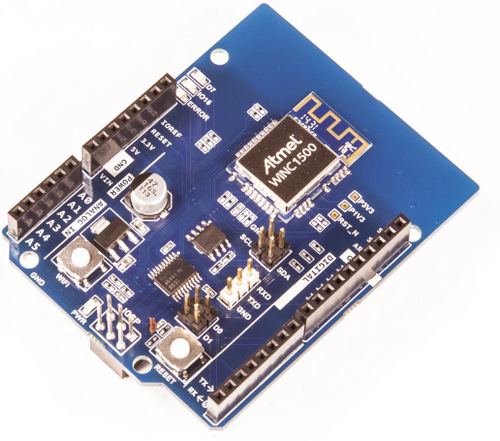Arduino and Atmel Launch Secure Wi-Fi Connectivity for All Arduino Platforms; Enables Unlimited Possibilities for Smart, Connected IoT Devices
Arduino LLC and Atmel Corporation announced the Arduino Wi-Fi Shield 101, a shield that enables rapid prototyping of Internet of Things (IoT) applications on the Arduino platform.

The cost-effective, secure Arduino Wi-Fi Shield 101 is an easy-to-use extension that can seamlessly be connected to any Arduino board enabling high-performance Wi-Fi connectivity. This new shield gives the design community more opportunities to securely connect IoT applications, ranging from consumer goods to wearables, robotics, high-tech devices and more. The Arduino Wi-Fi Shield 101 is powered by Atmel’s wireless network controller, part of the Atmel SmartConnect family. It also includes the ATECC108 device, from the Crypto Authentication family, which allows users to easily incorporate hardware authentication capability in their design.
Arduino Wi-Fi Shield 101
The Arduino Wi-Fi Shield 101 can be connected to any modern Arduino R3 board, enabling connectivity to the Internet using any traditional Wi-Fi access points. It is based on the WINC1500 802.11b/g/n network controller which features an integrated TCP/IP stack, TLS security and SoftAP for seamless provisioning.
Atmel SmartConnect-WINC1500 is an IEEE 802.11 b/g/n IOT network controller SoC. The WINC1500 connects to any Atmel AVR or SMART MCU with minimal resource requirements. The WINC1500 most advanced mode is a single stream 1x1 802.11n mode providing up to 72 Mbps PHY throughput. WINC1500 features fully integrated Power Amplifier, LNA, Switch and Power Management. The WINC1500 provides internal Flash memory as well as multiple peripheral interfaces including UART, SPI, and I2C.
It also features an Atmel authentication security device that can be used for keys, passwords or secret data. An open-source Wi-Fi library will also be available to enable users to write sketches that connect to the Internet using the shield. The Wi-Fi shield connects to an Arduino board using long wire-wrap headers which extend through the shield. This keeps the pin layout intact and allows other shields to be stacked on top.
